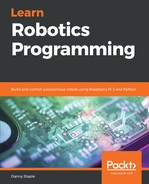A headless system is a computer designed to be used from another computer via a network, for when keyboard, screen, and mouse access to a device is inconvenient. Headless access is used for server systems and for building robots. Refer to the following diagram:

The preceding diagram shows a system with a head where a user can sit in front of the device. You would need to take a screen, keyboard, and mouse with your robot—not very mobile. You may be able to attach/detach them as required, but this is also inconvenient and adds bulk. There are systems designed to dock with Raspberry Pis like this and are portable, but when a robot moves, you'd need to disconnect or move with the robot.
I have seen, at some events, a robot with a tiny screen attached and someone using a wireless keyboard and mouse as an option. However, in this book we are going to focus on using a robot as a headless device. Take a look at the following diagram:

The Raspberry Pi in the preceding diagram is mounted on a robot as a headless device. This Raspberry Pi is connected to batteries and motors, but not encumbered by a screen and keyboard; those are handled by another computer. The Pi is connected wirelessly to a network, which could be through a laptop. Code, instructions, and information are sent to and from the Raspberry Pi via this wireless network. To interact with it, you use the screen and keyboard on your laptop. However, you would usually expect your robot to function autonomously, so you would only connect to the Pi to modify things or test code. As an alternative to bringing a laptop to control a robot everywhere, it can be more convenient to add a few indicator LEDs (which we will add in Chapter 9, Programming RGB Strips in Python) and a wireless Joypad (to be added in Chapter 15, Programming A Gamepad On Raspberry Pi With Python) so you can start and stop autonomous behaviors, view the robot's status, or just drive it without needing to hook up the laptop at all. This Raspberry Pi is free from the screen and keyboard.
For our headless access to the Raspberry Pi, we will be using the SSH system, a secure shell. SSH gives you a command line to send instructions to the Pi and a file transfer system to put files onto it. As SSH connects over a network, we need to configure our Raspberry Pi to connect to your own wireless network.
Making a Pi headless makes it free to roam around. It keeps a robot light by not needing to carry or power a screen and keyboard. Being headless makes a robot smaller, since a screen and keyboard are more bulky. It also encourages you, the maker, to think more about autonomous behavior since you can't always type commands to the robot.
